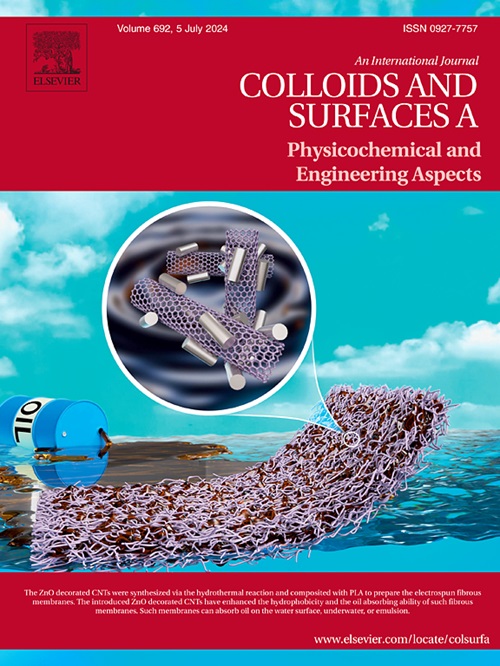不同亲水结构表面活性剂对煤的动态润湿性分级及润湿机理研究
IF 5.4
2区 化学
Q2 CHEMISTRY, PHYSICAL
Colloids and Surfaces A: Physicochemical and Engineering Aspects
Pub Date : 2025-07-17
DOI:10.1016/j.colsurfa.2025.137787
引用次数: 0
摘要
表面活性剂的亲水结构显著影响其动态润湿性能。以往的研究主要采用静态方法和参数评价表面活性剂对煤的润湿性,而对动态润湿性的研究较少,特别是基于最大无量纲润湿面积的润湿性量化和分级研究较少。因此,本研究采用冲击润湿实验和分子动力学模拟相结合的方法,研究亲水基团类型和链长对煤表面液滴最大无量纲润湿面积的影响。对溶液的动态润湿性进行了分级,分析了不同亲水性结构表面活性剂的微观润湿机理。结果表明,在相同浓度下,最大的无量纲润湿面积依次为:醇醚硫酸钠(AES) >; 十烷基乙二醇单十二烷基醚(C12E10) >; 十二烷基三甲基溴化铵(DTAB)(按亲水性基团排列)和OP-10 >; OP-40 >; OP-7(按链长排列)。根据动态润湿性分级标准,AES为强润湿溶液,DTAB为弱润湿溶液,C12E10浓度超过0.03 %时为强润湿溶液,3种辛基酚聚氧基酸表面活性剂(OP-7、OP-10、OP-40)为强润湿溶液。分子动力学模拟结果表明,AES和OP-10体系在各自组内的相对浓度、相互作用能和水分子扩散系数均最佳,润湿性最强。径向分布函数分析显示亲水性结构的润湿性趋势如下:硫酸盐基>; 羟基>; 乙氧基>; 季铵基。本文章由计算机程序翻译,如有差异,请以英文原文为准。
Study on dynamic wettability grading and wetting mechanism of coal by surfactants with different hydrophilic structures
The hydrophilic structure of surfactants significantly influences their dynamic wetting performance. Previous studies mainly used static methods and parameters to assess surfactant wetting on coal, with limited research on dynamic wetting, especially in quantifying and grading wettability based on maximum dimensionless wetting area. Therefore, this study employs a combined approach of impact wetting experiments and molecular dynamics simulations to investigate the effects of hydrophilic group type and chain length on the maximum dimensionless wetting area of droplets on coal surfaces. The dynamic wettability of the solutions was graded, and the microscopic wetting mechanisms of surfactants with different hydrophilic structures were analyzed. The results demonstrate that, at identical concentrations, the maximum dimensionless wetting area follows sodium alcohol ether sulfate (AES) > decaethylene glycol monododecyl ether (C12E10) > dodecyl trimethyl ammonium bromide (DTAB) (by hydrophilic group), and OP-10 > OP-40 > OP-7 (by chain length). According to the dynamic wettability grading criteria, AES was categorized as a strong wetting solution, DTAB was classified as a weak wetting solution, C12E10 exhibited a strong wetting solution when its concentration exceeded 0.03 %, and three octylphenol ethoxylate surfactants (OP-7, OP-10, OP-40) qualified as strong wetting solutions. The molecular dynamics simulation results revealed that the AES and OP-10 systems exhibited optimal relative concentration, interaction energy, and water molecule diffusion coefficients within their respective group, with the strongest wettability. Radial distribution function analysis demonstrated the following wettability trend for hydrophilic structures: sulfate group > hydroxyl group > ethoxy group > quaternary ammonium group.
求助全文
通过发布文献求助,成功后即可免费获取论文全文。
去求助
来源期刊
CiteScore
8.70
自引率
9.60%
发文量
2421
审稿时长
56 days
期刊介绍:
Colloids and Surfaces A: Physicochemical and Engineering Aspects is an international journal devoted to the science underlying applications of colloids and interfacial phenomena.
The journal aims at publishing high quality research papers featuring new materials or new insights into the role of colloid and interface science in (for example) food, energy, minerals processing, pharmaceuticals or the environment.

 求助内容:
求助内容: 应助结果提醒方式:
应助结果提醒方式:


